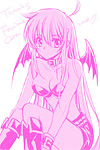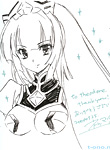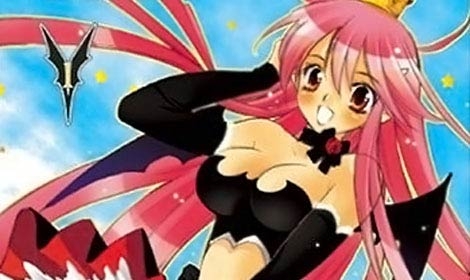Despite the harried Sunday when Maika Netsu presented a panel and signing session at Fanime Con 2008, she found some time to talk about her life as a female mangaka in Japan. The-O Network talked to her about her latest state-side release of My Dearest Devil Princess and her working life back in Japan.
Netsu uses her real name for her work and only changed her kanji reading to katakana since some readers may grow confused about the reading. Her works usually border on the ecchi as she drew doujinshi before being scouted by Jive Ltd. She currently works on Kaprekar.
Initially, she began drawing in her early teens in school and moved into doing comics in her first year of high school. She made a copybook with her friends and began her career in doujinshi. Since then, she says she has continued with her doujin work. Her non-corporate work; however, was not up for discussion. Her family at first disagreed with her decision to work on manga, but as time passed since her debut in 2000, her family embraced her job and even felt pride in her accomplishments.
Her works possess a wide collection of influences for her work. From Yoshihiro Togashi (Yu Yu Hakusho) to Rumiko Takahashi (Urusei Yatsura), she takes inspiration for her work and style from a wide variety of artists. Netsu takes in from so many artists that she professes that “there are just so many artists, I can't say any particular one.” She continues to take inspiration from all over the industry as she diligently continues to read Shounen Jump since the young age of ten. On top of Jump, Netsu reads a number of magazine serials, mostly in the shonen and seinen genre.
 On top of her influences from those artists, Netsu also embeds her own beliefs and images she's held from her childhood into her character designs. The pointed devil tail and black wings on Maki in Devil Princess stem not from any particular influence, but from her own memories of what devils tended to look like from her childhood. Through trial and error, Netsu would try out several color schemes on her characters. Her use of the color pink for Maki's hair was based on the fact that she needed to look out of this world and attract the reader's attention.
On top of her influences from those artists, Netsu also embeds her own beliefs and images she's held from her childhood into her character designs. The pointed devil tail and black wings on Maki in Devil Princess stem not from any particular influence, but from her own memories of what devils tended to look like from her childhood. Through trial and error, Netsu would try out several color schemes on her characters. Her use of the color pink for Maki's hair was based on the fact that she needed to look out of this world and attract the reader's attention.
As a woman in the field, Netsu has encountered very little resistance in her work in the comic world. While some imprints in the manga industry hold the gender of their artists, Jive made no editorial decision to do so. Netsu seems truly comfortable with herself in her work.
“I haven't encountered much prejudice since I debuted. There may have been some discrimination ten years ago, but it's mostly gone now,” says Netsu.
Netsu has no problem making public appearances at conventions, such as Fanime, and she does avoid using a pen name.
Perhaps even more curious about her, though, is her working schedule. Whereas the stereotype shows mangaka as a rather sloven bunch, prone to all-nighters and panicked bouts of drawing as due dates come closer, Netsu keeps a fairly good schedule that enables her to sleep. When asked about all-nighters, Netsu replied, “All-nighters? No, I usually get about three to six hours of sleep every night.” Though her sleeping pattern seems a bit nocturnal: “I usually work from midnight to six in the morning, then I sleep till ten or noon.”
Her entire production schedule usually spans two weeks from start to finish. In one week, she finishes up the rough outlines of the comic after receiving the story from the writer. She talks with the writer and her editor and once the okay is given, she goes into drawing the actual comics. She quickly moves through rough drafts, inks, and colors in another week with the help of two or three assistants. The assistants only come in for three, or four days in the final steps of production to help her do backgrounds, inks, and tones. The group of artists live and work on the comic in Netsu's home/office for the 3 or 4 days they are there. “One of them's pretty good at cooking, so she makes us food. We eat together.”
 When asked about any interesting happenings that she may recall from her days in production, she told The-O Network that she lamentably has few. “Since we tend to get enough sleep, nothing too strange seems to happen,” she joked. Even then, she does recall that she had her small share of mundane adventures.
When asked about any interesting happenings that she may recall from her days in production, she told The-O Network that she lamentably has few. “Since we tend to get enough sleep, nothing too strange seems to happen,” she joked. Even then, she does recall that she had her small share of mundane adventures.
“I recall that once, a cockroach came into our room.” Netsu and her all-female production staff proceeded to flee from the gross adversary until one of them fought back. “We did manage to fight him off, and the manga proofs were safe.”
In another instance, one of her assistants showed her Kisaragi during one of their meals. Where they only meant to watch an episode with their meal, Netsu and company were glued to the screen for two hours until the first DVD finished. To that, Netsu's editor looked at her with a side glance commenting, “I never heard that story before...”
Her editor, despite his prodding on Netsu's aforementioned slip-up, is a very lax man. “I hear there are editors who nitpick and force changes on every little thing,” Netsu explained. “When I hear that when some of my peers get such an editor, I can only say 'ganbare' to them.” She appears to meet eye-to-eye with her current editor, and is thankful for it.
“I like to protect the creativity of the authors.” Netsu's editor said. “Forcing them to work isn't all that fun for them.”
For the future, Netsu has a number of ideas in store. She might do a story on a group of child detectives who form a club, or one on a doctor whose practice serves a plethora of youkai and other traditional Japanese monsters in the night. These ideas, however, are not set in stone, and what Netsu might work on next is still unknown.
“Lots of ideas can go out at the drop of a hat. I can only submit more to the publishing department to see what they think of them.”

